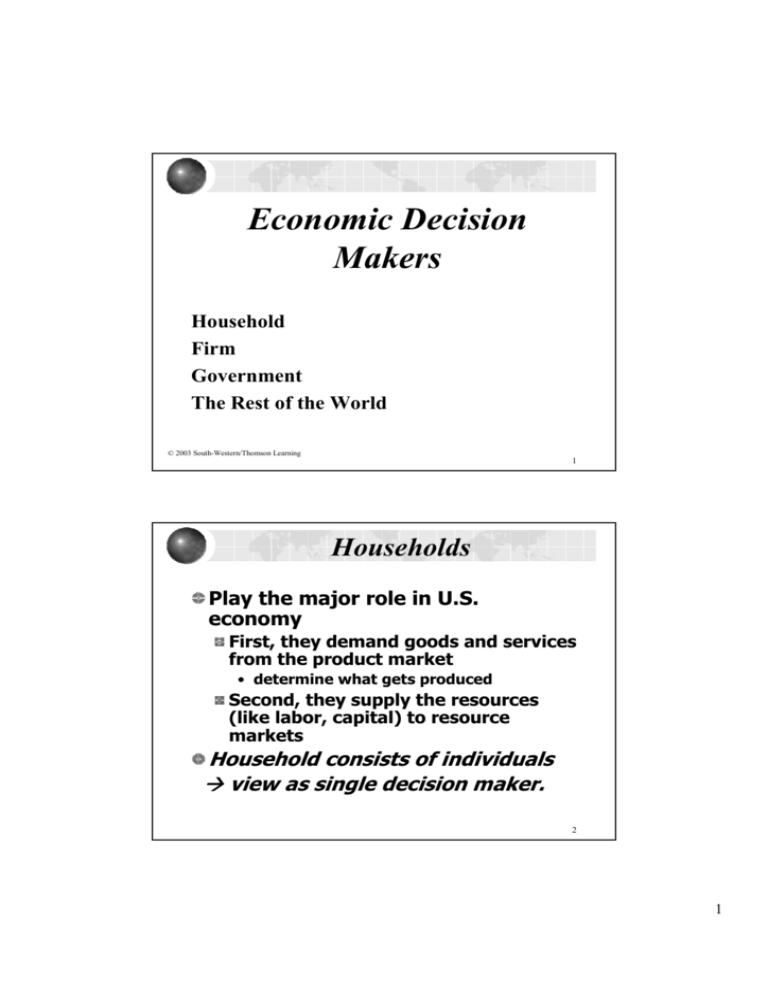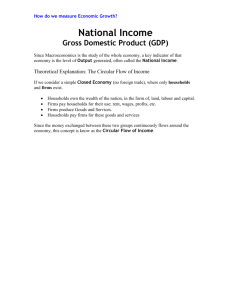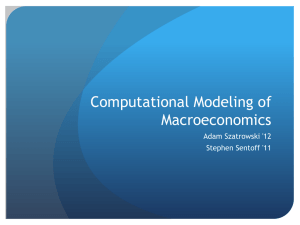Economic Decision Makers
advertisement

Economic Decision Makers Household Firm Government The Rest of the World © 2003 South-Western/Thomson Learning 1 Households Play the major role in U.S. economy First, they demand goods and services from the product market • determine what gets produced Second, they supply the resources (like labor, capital) to resource markets Household consists of individuals Æ view as single decision maker. 2 1 Evolution of Households 農業社會Æ工業社會 Agricultural economy, Household was largely self-sufficient They produced what they consumed and consumed what they produced Improvement of agriculture Seeds, labor saving machines Few farmers are required Growth of urban factories increased the demand for factory labor Less self-sufficient 3 Evolution of Households 女性就業人口上升 Increase of women in the labor force Increased opportunity cost of working in the home Higher wages In US, more than half of married women with children are in the labor force Less production takes place in the home female labor participation rate has increased 4 2 Evolution of Households 雙薪家庭 The rise of two-earner households has affected the family as an economic unit Less production occurs in the home, and more goods and services are demanded from the market It has also reduce the advantages of specialization within the household A central feature of a farm family 5 Households Maximize Utility Assume that people attempt to maximize their level of satisfaction, Î maximize utility Utility: The satisfaction received from consumption; sense of well-being Households are viewed as rational Î Try to act in the best interest of the household ÆWould not deliberately make choices that are likely to make them worse off 6 3 Households as Resource Suppliers Households use their limited resources Labor, capital, land, entrepreneurial ability to satisfy their unlimited wants Resources can be used to produce goods and services in the home sold in the resource market to receive income buy goods and services in the product market Next slide shows the sources of personal income in 2000 in US. Personal income totaled about $8 trillion 7 Sources of U.S. Personal Income in 2000 Personal Interest 13% Wages and Salaries 64% ts en m y Pa r % e f s 8 Self-employed an come n Tr I s r to Ex: Doctor Proprie % 8 Divid ends 5% Re nta l In c om e2 % : Nearly two thirds of personal income was labor income. 8 4 Transfer Payments Political power decides those who cannot provide for themselves receive assistance from the government in the form of transfer payments Transfer payments are cash or in-kind benefits given to individuals as outright grants from the government Cash transfers are monetary payments: welfare benefits, unemployment compensation, etc. In-kind transfers provide specific goods and services : Like food stamps, Medicare 9 政府社會救助的設定 政府界定窮人的標準是:台灣各縣市每人每月的收入 不超過八千四百元,高雄市不超過九千多元,台北市 不超過一萬一千多元,還要加上家戶之內成員收入及 各項財產審查。 目前界定貧窮線在執行上是有很許多問題,包括貧窮 認定不是依個人而是依家戶、家庭成員要算到多廣的 親戚、財產中無法買賣變現的不動產是不是該算入, 比如空有土地持分卻無法買賣的都併入計算,失業人 口明明沒所得,也自動「設算所得」為基本工資一萬 五千八百四十元,是最被質疑的。政策「懲罰」失業 者,假設人是因為懶惰才不去工作,忽略人浮於事的 事實。 10 5 Households as Demanders of Goods and Services On average, about 81 percent of U.S. personal income goes to personal consumption, about 3 percent is saved, and 16 percent goes for taxes Personal consumption commonly divided into three categories See next slide 11 Spending of Personal Income Services such as haircuts and medical care account for the largest share and is the fastest growing category. Nondurable goods 24% Nondurable goods Taxes 16% are items such as food and clothing. Durable goods are designed to last three years or more: automobiles, appliances, etc. Durable goods 10% Services 47% Ot he r 3% 12 6 Economic Decision Makers Household The efficiency coming from Firm comparative advantage results in great specialization Government The Rest of the World © 2003 South-Western/Thomson Learning 13 The Evolution of the Firm The individual consumer could take the process of negotiating with all the necessary parties to produce a particular product ` Ex:麵包: 農夫,貨車司機,麵包師父 The resulting transaction costs could easily erase the gains from specialization The consumer pay someone to take all these tasks – the entrepreneur who organizes the production process and reduces transaction costs 14 7 The Evolution of the Firm (家庭化生產Æ現代工廠) 200 years ago, profit-seeking entrepreneurs put out raw material in households and turned it into products. cottage industry system • production process took place in the workers’ cottages As the British economy expanded in the 18th century, entrepreneurs began organizing the various stages of production under one roof 15 The Evolution of the Firm 工業革命 Technological advances increased worker productivity shift of employment from rural to urban Work became organized in large, centrally powered factories that Promoted a more efficient division of labor Allowed for the direct supervision of production Reduced transportation costs Facilitated the use of machines far bigger than anything that had been used in the home Industrial Revolution 16 8 The Evolution of the Firm Production evolved from self-sufficient rural households cottage industry Modern firms Firms are economic units formed by profit-seeking entrepreneurs combine the resources to produce goods and services Assume firms attempt to maximize profits • entrepreneur’s reward = revenue minus cost of production 17 Why Does Household Production Still Exist? Some activities requires few skills and resources Like sweeping the floor Household production avoids taxes Government tax income, sales, market transaction Household production has lower transaction costs if we want our house painted we could get bids from contractors, hire a contractor, negotiate terms, and monitor job performance. Doing the job yourself reduces these transaction costs and allows for more personal control Various technological advances – dishwashers, microwave ovens, PC’s, 18 9 Three Types of Firms: First: Sole Proprietorship Simplest form a firm with a single owner who has the right to all profits Like farmer, dentist Complete control Disadvantages Unlimited liability for any business debts and can lose personal assets Goes out of business upon the death of the proprietor 19 Partnership A firm with multiple owners who share the firms profits Law, accounting, and medical partner Easier to raise sufficient funds to get the business going Disadvantages Each partner usually faces unlimited liability Partners may not agree The death or departure of one partner may force costly reorganization 20 10 Corporation Corporation is a legal entity owned by stockholders Advantages The easiest way to raise capital funds (by stock) Stockholders have limited liability • Limited to the value of their stock Third, corporation has a life apart from its owners 21 Corporation Disadvantages Stockholder can influence corporate policy by voting board of directors. Corporate income is taxed twice: • Corporate profits • stockholder income, either as corporate dividends or as realized capital gains • Realized capital gain (已實現的資本利得) is increase in the market value of a share that occurs between the time the share is purchased and the time it is sold 22 11 現行法制:兩稅合一制度 兩稅合一是消除營利所得重複課稅的稅制, 認 為公司為法律的虛擬體, 不具獨立納稅能力, 僅是作為把盈餘傳送給股東的導管, 所以公司 階段的所得與股東階段的股利, 應僅課徵一次 所得稅, 此即為通稱的兩稅合一制。 相對於兩稅合一的稅制稱為獨立課稅制, 將公 司與股東視為獨立的個體, 公司的所得在公司 階段課徵一次所得稅後, 其盈餘分配予股東 時, 股東須再繳納一次所得稅, 因此, 投資 所得在公司階段與股東階段一共繳納兩次所得 稅, 造成重複課稅。 23 現行法制:資本利得不課稅 世界先進國如美、日、英、德等國均對資本利得課以所得稅,其 中,日本同時課徵證所稅及證交稅,證所稅高達百分之二十六; 美國證券交易所得併入個人所得課稅,稅率最高百分之二十八, 加拿大、英國、德國也都有類似稅目。 課徵證所稅,幾乎被多數人民反對;因為台灣民眾投資股市的比 例很高,加上大部分股民(散戶)投資股市是損失多於獲利,在 只對獲利課稅的情況下,自然影響投資意願。 所以證所稅是股市的「死穴」,如一九八八年九月復徵證所稅事 件,台股連續十七天跌停,去年七月也傳出疑似要復徵證所稅, 大盤指數又應聲下挫。而五月五日財政部長林全提出要把法人的 證券交易所得納入最低稅負制中,當然又再度造成股民的震撼。 24 12 S Corporation A hybrid of corporation and partnership Take advantage of the limited liability feature of the corporate structure income is only taxed once as profits Limited no more than 75 stockholders No foreign and corporate stock holders 25 Number and Sales of Each Type of Firm Corporations 20% Percentages by Type Partnerships 7% Sole Proprietorships 73% Percentages of Sales by Type Corporations 88% Partnerships 7% Sole Proprietorships 5% Corporations make up only 20% of all U.S. businesses but account for 88% of all sales. Sole proprietorships make up 73% of all U.S. businesses but account for only 5% of all sales. 26 13 Nonprofit Firms Private organizations that do not have profit as an explicit objective Ex: 財團法人 Red Cross, Salvation Army Nonprofit institutions have to generate enough revenue to pay for the resources they use 27 Economic Decision Makers Household Firm Government The Rest of the World © 2003 South-Western/Thomson Learning 28 14 Why Government Involved? Unrestrained operation of markets sometimes yield undesirable results Too many of some goods and too few of other goods may be produced Sources of market failure • 市場失靈是指在某些外在因素的影響下,使得市場在自由 運作下無法達到最有效率的結果。造成市場失靈的可能原 因包括:自然獨占、外部性、及訊息不對稱等因素。 and society’s overall welfare could at times be improved through government intervention 29 Government Role of Government Establishing and enforcing the rules of the game through judicial system Promoting competition Regulating natural monopolies Providing public goods Dealing with externalities More equal distribution of income Full employment, price stability, and economic growth 30 15 The Rules Of The Game Governments play a role safeguarding private property enforcing contracts through a judicial system 31 Promoting Competition Some firms try to avoid competition through collusion (聯合壟斷) Government antitrust laws (反托拉斯法) try to promote competition by prohibiting collusion and other anticompetitive practices Ex:公交會 32 16 Regulating Natural Monopolies Competition normally keeps the product price lower than it is when the product is sold by a monopoly Monopoly is a sole producer of a product for which there are no close substitutes When it is cheaper for one firm to serve the market than for two or more firms to do so, that firm is called a natural monopoly(自然獨占: 電力 自來水) A natural monopoly may maximize profit by charging a price higher than is optimal from society’s point of view Î government usually regulates these firms 33 The difference between Private and Public Goods Private goods have two important features The amount consumed by one person is unavailable for others to consumer Second, the supplier of a private good can easily exclude those who fail to pay By way of contrast, public goods are goods that once produced, are available for all to consume National defense, system of justice, monetary system Ex : 34 17 Providing Public Goods One person’s consumption does not diminish the amount available to others Î they are non-rival in consumption Public goods are available to all Î they are non-exclusive Î suppliers cannot easily prevent consumption by those who fail to pay Because public goods are non-rival and non-exclusive, private firms cannot sell them profitably 35 What is Externalities Market prices reflect the private costs and benefits of producers and consumers Production or consumption may impose costs or benefits on third parties who are not a part of the market transaction These costs or benefits are external to market activity, they are called externalities 36 18 Dealing With Externalities Negative externality imposes a cost Ex: Pollution, jet noise, Positive externality confers benefits Ex: Education Market prices do not reflect externalitiesÆ governments employ taxes, subsidies, and regulations to discourage negative externalities and encourage positive externalities 37 A More Equal Distribution Of Income Resource markets do not guarantee each household even a minimum level of income Transfer payments reflect in an society’s attempt to provide a basic standard of living to all individuals Many agree that society should redistribute income to the poor. Opinion arises on How much should be redistributed? What form should it take? Who should receive the benefits? How long should those benefits continue? 政府社會救助的設定 38 19 Full Employment, Price Stability, And Economic Growth Government attempts to promote full employment, price stability, and an adequate rate of economic growth Fiscal policy (財政政策) refers to the use of government purchases, transfer payments, taxes, and borrowing to influence aggregate economic activity Monetary policy (貨幣政策)refers to regulation of the money supply in order to influence aggregate economic activity 39 凱因斯的政策 假設政府花錢找一批人來挖一個大洞,再找一批人把 洞填回平地,也就是說這些人完全是做沒有用的白 工,好像對經濟不會有任何貢獻。但這些工人得到工 資而有了收入,他們就會增加消費等支出,也就是會 向別人買東西,而賣東西給他們的人之生意和收入也 就跟著增加,同時也因而可以增加他們對別人的支 出,並使另一批人的收入增加。如此繼續下去,全社 會增加的收入將是政府最初支出增加金額的好多倍, 而得到相當大的提振景氣之效果。這也就是凱因斯所 稱的乘數效果。 40 20 Size and Growth of Government One of most useful ways to track the role of government Compare government spending to gross domestic product, or GDP GDP is the total value of all final goods and services produced in the United States In 1929, the year the Great Depression began, government spending about 10% of GDP By 1992, government spending was 35 percent of GDP By 2000 government outlays were 29% of GDP 41 Size and Growth of Government Government outlays relative to GDP in other countries 38% in Japan, the United Kingdom, and Canada 43% in Germany 47% in Italy 51% in France In the 36 largest industrial economies, the average was 36% of GDP in 2000 42 21 Sources of Government Revenue Taxes are by far the largest source of revenue at all levels of government Federal government relies primarily on the individual income tax state governments on income and sales taxes local government on the property tax See next slide 43 Percent of Federal Revenue Federal Government Receipts 100 90 80 70 60 50 40 30 20 10 0 All Other Revenue Corporate Income Taxes 工資稅 Payroll Taxes ( ) Individual Income Taxes 1960 1965 1970 1975 1980 1985 1990 1995 2000 44 22 Tax Principles The structure of a tax system is often justified on the basis of one or two general principles Ability-to-pay principle those with a greater ability to pay should pay more tax (Ex: 所得稅) Benefits-received tax principle those who receive more benefits from the government program funded by a tax should pay more tax (Ex:汽車牌照稅) 45 Tax Incidence Tax incidence indicates who actually bears the burden of a tax The most common way of evaluating tax incidence is by measuring the tax as a percentage of income 46 23 Tax Incidence Proportional tax At all income levels pay the same percentage of income taxes Also called a flat tax Progressive (累進稅率) The percentage of income paid in taxes increases as income increases Regressive The percentage of income paid in taxes decreases as income increases 47 Marginal Tax Rate Marginal tax rate (MTR) measures the percentage of each additional dollar of income that goes to tax MTR = ∆ Tax / ∆ Income High marginal tax rates significantly reduce the after tax return Î incentives to work or invest are reduced 48 24 A Numerical Example Income Progressive Flat Regressive 1000 100 100 100 2000 300 200 150 3000 600 300 175 Evaluate tax incidence and marginal rate. 49 我國的稅改政策 林全表示,我國綜所稅最高邊際稅率是40%, 雖然跟南韓、日本差不多,但比香港的17.5% 及新加坡的20%高很多,因此常有人批評40% 的最高邊際稅率會打擊投資及工作意願,但如 果單獨調降綜所稅最高邊際稅率,又會被質疑 是圖利富人。 因此,林全表示,等到最低稅負制實施有所成 效,高所得者繳了一些稅之後,再來考慮調降 綜所稅最高邊際稅率,也就是「收多少、降多 少」、「不見兔子不放鷹」,外界的質疑聲浪 也會比較小。 50 25 Economic Decision Makers Household Firm Government The Rest of the World © 2003 South-Western/Thomson Learning 51 Merchandise trade balance International trade arises Î the opportunity cost of producing specific goods differ among countries Merchandise trade balance (商品貿易差額) =value of a exported goods - value of its imported goods (during a given time period) The merchandise trade balance distinguishes between goods and services 52 26 新聞:一至八月貿易出超同比減少79.1% 財政部昨天發布八月份海關出口值為一 五八點六億美元,創歷年單月次高紀 錄,進口值一五四點三億美元,也是單 月第六高,出超為四點三億美元。累計 一至八月貿易出超則為十一點七億美 元,較去年同期減少四十四點五億美 元,減幅七十九點一%。 53 How to Finance Merchandise Trade Deficit USA experienced a merchandise trade deficit Î the value of goods imported to U.S. ≧ the value of U.S. goods exported Deficit must be offset by a surplus in one or more of the other balance-ofpayments accounts 購買美債,房地產,投資 Balance of payments : A record of all economic transactions between residents of one country and residents of the rest of the world during a given time period 54 27 Foreign Exchange The lack of a common currency complicates trade between countries To facilitate trade when two currencies are involved, a market for foreign exchange has developed Foreign exchange (外匯) is a foreign currency needed to carry out international transactions 55 Exchange Rates The exchange rate measures the price of one currency in terms of another The supply and demand for foreign exchange determine the equilibrium exchange rate between two countries The greater the demand for a particular foreign currency or the smaller its supply, the higher its exchange rate 56 28 What Exchange Rates Influence Exchange rate affects the prices of imports and exports and helps shape the flow of foreign trade The exchange rate between the EUR and the USD indicate that one EUR exchanges for $0.90 USD A good selling for $100,000 EURs would cost an American consumer $90,000 USDs 較廉價台幣有助於出口 57 Trade Restrictions Nearly all countries impose restrictions on international trading These restrictions can take one of three forms Tariffs which is a tax on imports or exports Quotas are legal limits on the quantity of a particular good that can be imported 58 29 Why Trade Restrictions if international trade is mutually beneficial, do most countries restrict this free flow of goods? Restrictions benefit domestic producers of these goods these groups of producers will lobby governments for these benefits while domestic consumers are generally unaware of their suffer 59 課堂報告 請舉例說明何謂 durable goods, nondurable goods 請簡介課本第75頁 Case Study: The electronic cottage 請舉例說明何謂 Natural Monopoly? 請舉例說明 private goods 和public goods 差別 請說明 何謂 Progressive taxation?我國有哪些稅採用 累進稅制? 請說明何謂trade restriction?請舉例說明我國曾採取哪 些貿易限制措施? 60 30 Homework 1. 請說明何者為耐久財,非耐久財和服務 Milk Æ nondurable 14. 分析下列事件對婦女就業的機會成本 的影響 教育程度提高Æ上升 17. 分析所得稅率及其制度 61 31








